#tay bridge disaster
Text

Album cover for Woe by The Great Park
from here
(original photo showing the aftermath of the 1879 Tay Bridge disaster – see here)
12 notes
·
View notes
Text
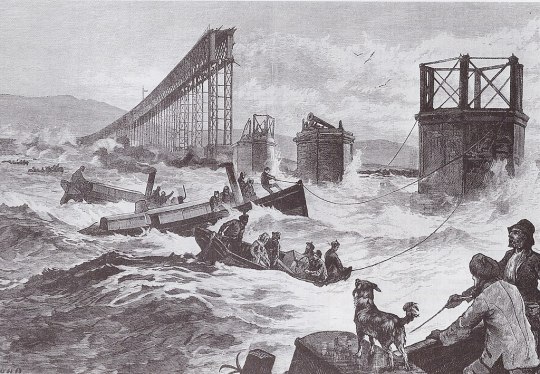
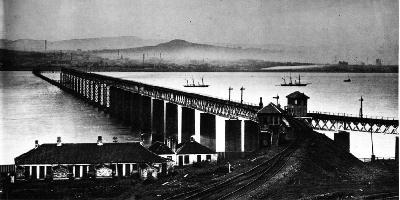


Just after 7pm on December 28th 1879 the Tay Bridge disaster occurred.
The first Tay Rail Bridge collapsed while a train was passing over it from Wormit to Dundee, killing all aboard.
At the time, a gale estimated at Beaufort force 10/11 was blowing down the Tay estuary at right angles to the bridge. The collapse of the bridge, only opened 19 months and passed safe by the Board of Trade, sent shock waves through the Victorian engineering profession and general public.
The disaster is one of the most famous bridge failures and to date it is still one of the worst structural engineering failures in the British Isles.
The first Tay rail bridge was completed in February 1878 to the design of Thomas Bouch. Bouch was responsible for the design, construction and maintenance of the bridge. Most of his bridges were lattice girders supported on slender cast iron columns braced with wrought iron struts and ties, such as the Belah Viaduct in the photograph to the right. The building of the Tay bridge culminated in him being knighted.
The Tay bridge was nearly two miles long, consisting of 85 spans and at the time was the longest bridge in the world. The spans carried a single rail track; 72 of these were supported on spanning girders below the level of the track; the remaining 13 navigation spans were spanning girders above the level of the track (i.e. the train runs through a tunnel of girders).
These "high girders", as they were known, were 27 ft high with an 88 ft clearance above the high water mark. It was these spans which fell. Most of the girders below track level, all of which remained standing, were transferred to the present Tay rail bridge. At the time of the collapse Bouch was working on the design of the proposed Forth Bridge. In consequence, the design of the bridge was transferred to Benjamin Baker and Sir John Fowler.
A Court of Inquiry was set up to try and ascertain the reason for the collapse of the bridge. The Court of Inquiry report concluded that, "The fall of the bridge was occasioned by the insufficiency of the cross bracing and its fastenings to sustain the force of the gale." The Court of Inquiry indicated that if the piers, and in particular the wind bracing, had been properly constructed and maintained, the bridge could have withstood the storm that night, albeit with a low factor of safety - 4 to 5 was the norm at the time.
A Court of Inquiry was set up to try and ascertain the reason for the collapse of the bridge. The Court of Inquiry report concluded that, "The fall of the bridge was occasioned by the insufficiency of the cross bracing and its fastenings to sustain the force of the gale." The Court of Inquiry indicated that if the piers, and in particular the wind bracing, had been properly constructed and maintained, the bridge could have withstood the storm that night, albeit with a low factor of safety - 4 to 5 was the norm at the time.
Sir Thomas Bouch was held chiefly to blame for the collapse in not making adequate allowance for wind loading. He used a wind pressure of 10 lbsf/sq ft for the design of the Tay bridge. It is interesting to note that when working on the design of a proposed Forth bridge he used 30lbsf/sq ft. To this day, however, there is still speculation as to the fundamental cause and as to whether or not the designer, Thomas Bouch, was to blame. You can find a modern re-appraisal of the disaster HERE.
Apart from the results of the original Court of Inquiry, various theories have been put proposed to explain the collapse.
The last two pictures shows the present Tay Rail bridge, the first shows the pier remains of Bouch's bridge alongside it. It is a very emotive site and provides a grim reminder of the disaster. The wrought iron girders which remained standing after the disaster were transferred onto the present bridge where they are still in use today.
19 notes
·
View notes
Text
Laird Hasenbär in Schottland - Tag 19 Teil 2
Lairds and Ladies!
Der zweite Punkt des heutigen Tages befasst sich mit der Erbauung der Tay Bridge und der daraus resultierenden Tragödie.
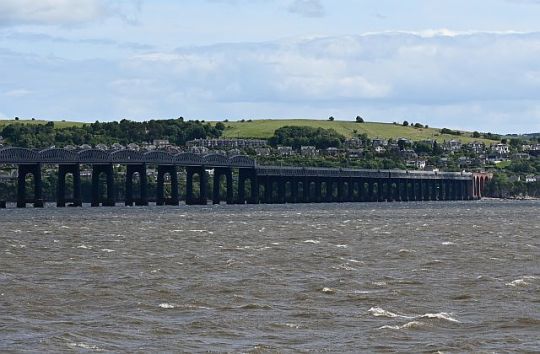
Da hier ein berechtigtes, berufliches Interesse an der Eisenbahnbrücke besteht, schauen wir uns das Bauwerk von allen Seiten an - und ich meine von allen Seiten!

Mehrere Stunden sind wir damit beschäftigt den richtigen Winkel und die richtige Position mit dem richtigen Blick zu finden.

Um 1900 beförderten Dampfer Urlauber zu (und von) so weit entfernten Orten wie Perth, Montrose und Leith, und 1905 wurde Broughty Ferry von den Straßenbahnen der Dundee, Broughty Ferry and District Tramways Company erreicht. Inzwischen war Broughty Ferry mehr oder weniger ein Vorort von Dundee. 1913 wurde die Stadt offiziell Teil der City of Dundee.

Der Fluss Tay (gälisch Tatha) ist der längste Fluss in Schottland und der siebtlängste in ganz Großbritannien. Der Tay gilt als eine der Lebensadern Schottlands, vor allem für die tieferen Highland Regionen ist der Tay ein wichtiger Fluss.

Der Fluss entspringt als River Connonish am Fuß des Ben Lui, kaum 30km von Oban und damit der Westküste Schottlands entfernt.

Er durchfließt danach unter den Namen River Fillan und als Dochart den Loch Dochhart, Loch Lubhair und Loch Tay. Eigentlich nennt sich der Fluss dann erst ab dem Abfluss aus dem Loch Tay dann Tay. Als Tay fließt der dann bis zu seinem niedrigsten Punkt bei Perth und liegt dort praktisch schon unter Einfluss der Gezeiten.
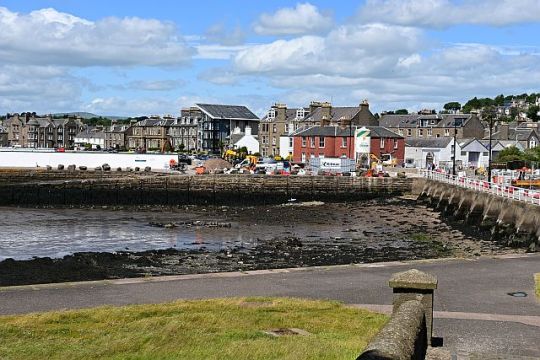
Die West-Ost Entfernung des Tay in Schottland beträgt 193 km. Dabei fließt er von einer Spitzenhöhe von 560 Meter über NN auf O Meter Meereshöhe. Letztendlich mündet der Tay südlich von Dundee in den Firth of Tay und schließlich in die Nordsee.
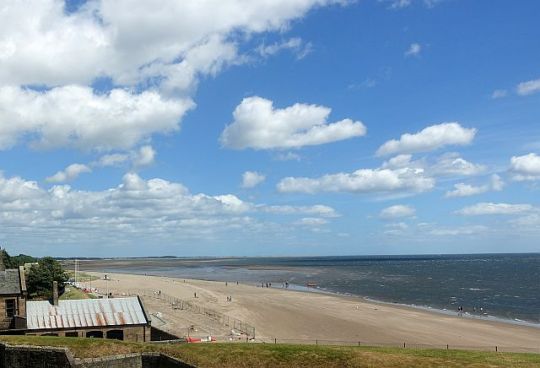
1870 verabschiedete das Parlament einen Gesetzentwurf für eine Eisenbahnbrücke über den Fluss bei der Stadt Dundee, die nach einem Entwurf von Sir Thomas Bouch gebaut werden sollte.
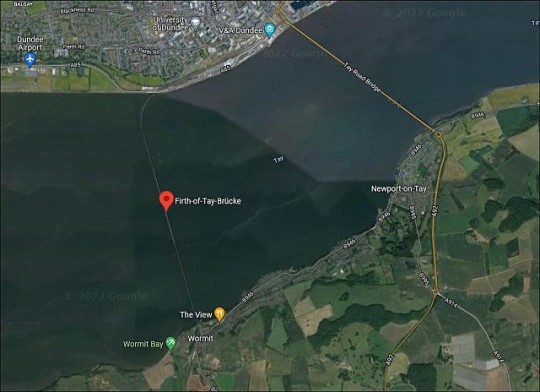
Seine Brücke sollte ein Gitterdesign sein, das Guss- und Schmiedeeisen kombiniert. Die Arbeiten begannen am 22. Juli 1871. Im weiteren Verlauf wurde jedoch klar, dass die Vermessungsarbeiten am Flussbett, die eine ebene Tiefe des Grundgesteins vorhergesagt hatten, falsch waren. Es wurde festgestellt, dass das Grundgestein in der Mitte des Flusses zu weit unter dem Flussbett lag, um das Gewicht der Brücke tragen zu können.
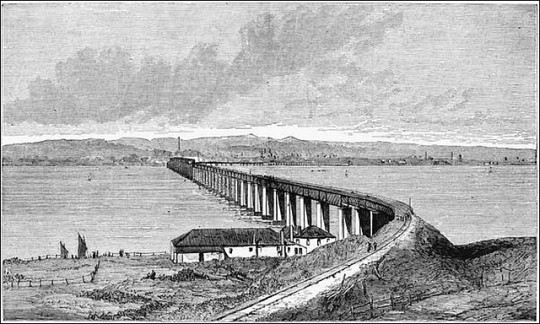
Bouch reagierte, indem er nun weite Teile des Oberbaus in fragilen Eisenkonstruktionen ausführen ließ. Außerdem wurden die Spannweiten erweitert und – um die Durchfahrtshöhe für Schiffe zu vergrößern – die Trägerwände im Mittelteil in die Höhe verlegt.

Viele Eisenteile, die in einer Behelfsgießerei am Ufer gegossen worden waren, wiesen Luftlöcher auf. Anstatt die Stücke wieder einzuschmelzen, waren die Fehler mit Farbe verdeckt worden.
Auch wurden Träger, die beim Bau ins Wasser fielen, nicht ausgetauscht, sondern geborgen und weiterverwendet, um das vorgegebene Budget der North British Railway über 300.000 Pfund nicht zu übersteigen und um im Zeitplan zu bleiben.
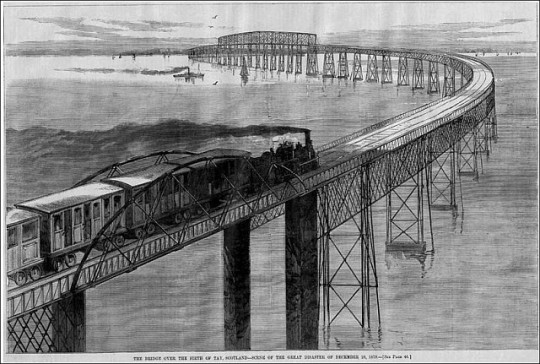
Als die Tay Rail Bridge am 1. Juni 1878 eröffnet wurde, war sie die längste der Welt und verkürzte die Fahrzeit zwischen Edinburgh und Dundee um eine Stunde. Königin Victoria, die bei der Eröffnung anwesend war, verlieh Bouch in Anerkennung seiner Leistung den Ritterschlag.
Die Firth of Tay Bridge war ein Bauwerk, das weltweit seines Gleichen suchte. Ein weiterer früher Reisender über die Brücke war der damalige Präsident der USA, Ulysses S. Grant. Er kommentierte, dass es sich um eine „große Brücke für eine kleine Stadt“ handelte.
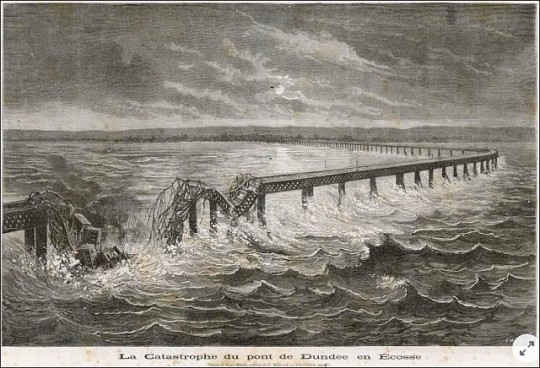
Ein Aushängeschild für die Macht und den Fortschritt Großbritanniens. Bis zum 28. Dezember 1879: Ein fürchterlicher Sturm peitschte an diesem Abend über Schottland.
Ein Sturm, welcher in Fontanes dichterischer Fantasie das Werk dreier Hexen war. Drei Hexen, welche schon in Shakespeares Drama "Macbeth" ihr Unwesen getrieben hatten und die eitlen Menschen zu bloßen Puppen degradierten, deren Schicksal sie mit sadistischem Vergnügen in den Abgrund lenkten. Auch die Fortschrittsgläubigen Passagiere des Zuges, welcher gegen 19 Uhr die Firth of Tay Bridge überquerte, sollten buchstäblich in diesem Abgrund landen.
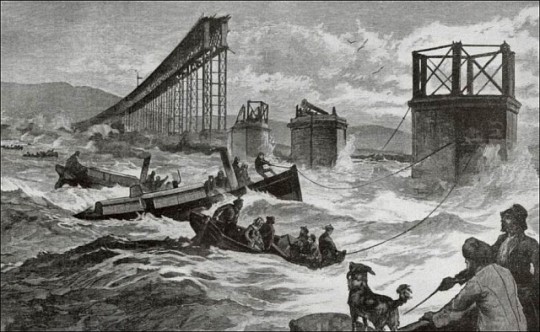
An diesem Sonntag hatte der Schnellzug nach Dundee den Bahnhof in Edinburgh gegen 16.15 Uhr verlassen.
Um 19.14 Uhr passierte der Zug noch unversehrt den südlichen Brückenkopf, wie Bahnwärter Sam O´Neill mitteilt. Da es nur einen „Token“ gab, war sichergestellt, dass nur jeweils ein Zug die eingleisige, 3264 Meter lange Brücke über den Fjord passierte. Danach sah O´Neill etwas wie einen Feuerstrahl und hörte Donnern.

Die stolze Brücke brach im Sturm unter der Last und dank ihrer zahlreichen Baumängel zusammen. Tragischerweise genau dann, als der Zug die Brücke überquerte.
Als der Zug nicht, wie erwartet, kurz darauf in den Bahnhof von Dundee einfuhr, machten sich Angestellte der Bahn auf die Suche. Als sie die Mitte der Brücke erreichten, gähnte vor ihnen ein fast 1000 Meter langes Loch. Der Zug mit sechs Waggons war in die Tiefe gestürzt.
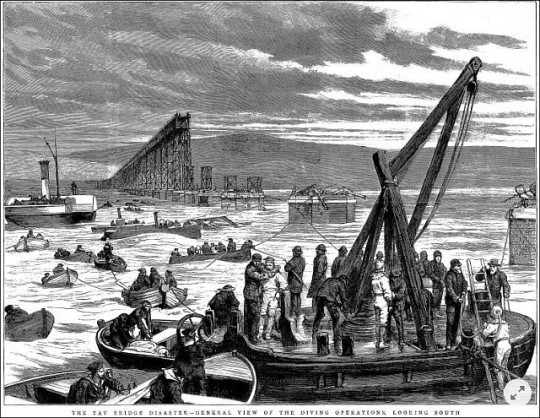
75 Menschen wurden getötet, darunter der Schwiegersohn von Sir Thomas und der Sohn des Bahnwärters, Jim O´Neill, der der Lokführer war. Viele von ihnen konnten nie geborgen werden. Ihre Leichen trieb die Strömung in die peitschende Nordsee hinaus.

An der Brückenstation von Dundee versammeln sich im Lauf der ersten Stunden nach dem Unglück Tausende von Menschen, die Näheres hören wollen über das Schicksal von Verwandten, Freunden oder Bekannten im Zug.

Darunter sind auch weitere Augenzeugen: das Ehepaar Dunston, das einen kranken Onkel in Pflege nehmen wollte, und der Geschäftsmann Warren Calcroft, der selbst zur Bahn gekommen war, um einen lange erwarteten Vertrag über die Fusion seiner Firma mit einem Pariser Partner in Empfang zu nehmen.
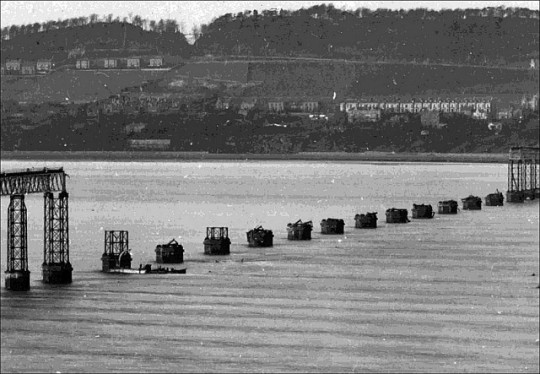
Das Dokument dürfte, wie alle Postsendungen aus dem Zug, flussabwärts im Wasser liegen: Der Sturm hat Menschenleben, Hoffnungen und nicht zuletzt einen Traum zerstört - den von der längsten Eisenbahnbrücke der Welt.
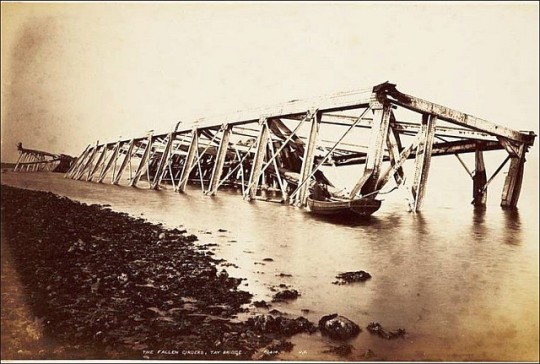
Eine öffentliche Untersuchung der Katastrophe kam zu dem Schluss, dass die Brücke "schlecht entworfen, schlecht gebaut und schlecht gewartet" worden war. Es traten Probleme mit der Qualität der verwendeten Materialien auf, und es scheint, dass Bouchs Entwürfe die Windlast auf die Struktur überhaupt nicht berücksichtigt haben.
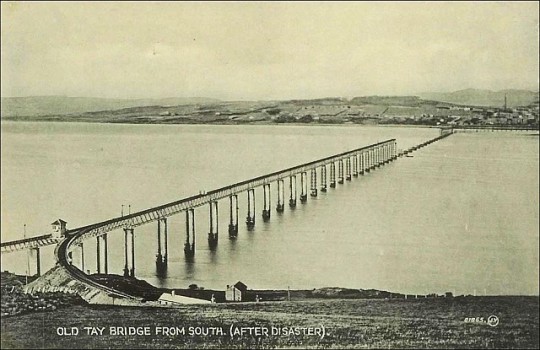
Sir Thomas Bouch starb wenige Monate nach der Veröffentlichung des Abschlussberichts der öffentlichen Untersuchung der Katastrophe. Er ist auf dem Dean Cemetery in Edinburgh begraben.
Zum Zeitpunkt der Katastrophe wurde an einer weiteren von Bouch entworfenen Eisenbahnbrücke, über den Fluss Forth, gearbeitet. Der Bau wurde sofort eingestellt.
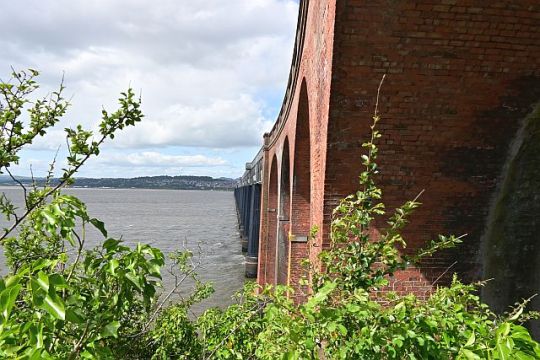
Als die Arbeiten an der Forth Bridge 1883 wieder aufgenommen wurden, handelte es sich um ein völlig neues und massiv stärkeres Design, das von Sir John Fowler und Sir Benjamin Baker entworfen wurde. 1883 begann auch der Bau der zweiten Tay Rail Bridge. Diese wurde am 13. Juli 1887 eröffnet und ist bis heute in Gebrauch.
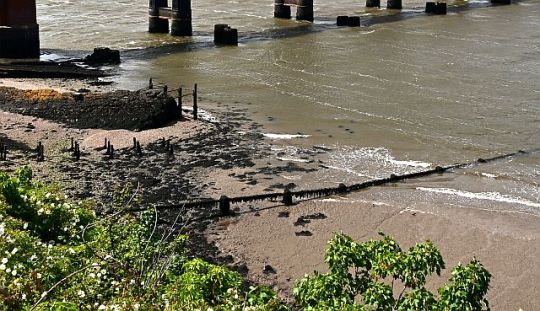
Erzählungen zufolge soll an jedem Jahrestag des Unglücks, 28.12.1879, ein Geisterzug über die nun neu erbaute Brücke fahren. Die Überreste der eingestürzten Brücke ragen noch immer wie ein Mahnmal im Wasser auf.
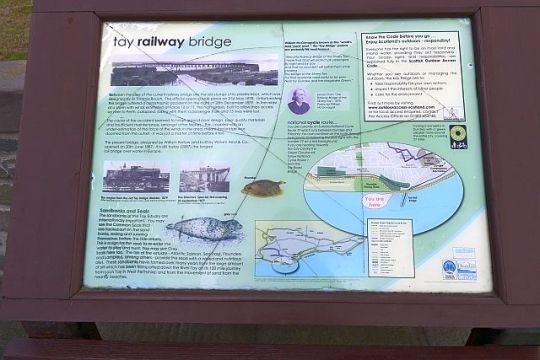
Der Katastrophe von Tay Bridge selbst wurde durch das bekannteste Gedicht von William McGonagall gedacht.

Am Nordufer des Tay River stehen inzwischen auch 3 Gedenksteine, die an die Opfer dieses Unglücks gedenken und alle Namen auflisten.
Oidhche mhath!
Angie, Micha und Laird Hasenbär
7 notes
·
View notes
Text
literally just realised that "william the gonnagle", terry pratchett's scottish bard character who defeats his enemies by reciting poetry at them, is a reference to "william mcgonagall", often hailed as the worst poet in the english language (or indeed any language). it has taken me a full two decades to understand this joke. discworld truly is the gift that never stops giving
#i must have read the wee free men upwards of twenty times and never got it#and then last week i was reading 'the tay bridge disaster' (mcgonagall's most famous Bad Poem) and i was like. hang on. OH FUCK.
69 notes
·
View notes
Text
"Beautiful railway bridge of the silv'ry Tay! / Alas! I am very sorry to say / That ninety lives have been taken away..."
Read it here | Reblog for a larger sample size!
#closed polls#polls#poetry#poems#poetry polls#poets and writing#tumblr poetry#have you read this#the tay bridge disaster#william mcgonagall
3 notes
·
View notes
Text
The Destruction of Engine Culture:
Ok, so this is going to be another long, and rambling post. So be warned. And as usual, this is a RWS theory post, so there will be talk of scrap.
That said, let's dive into the destruction of engine culture.
So, I think the first thing to ask is what would be 'engine culture' and how would it affect the railways of Britian (and globally) - and the answer is quite simple: it's the same as human culture. Humans have developed cultures for millennia, and they are often quite similar, and this is hypothesized to be because these cultures had similar things to warn about. Warning about the dangers of flooding, of wild animals, of droughts and fires. Many of the oldest stories are tales told to teach practical lessons. Little Red Riding Hood is as much about stranger danger and the threat wild animals pose as it is a story about a crossdressing wolf. Some scientists believe games like tag and catch were developed by our hunter-gatherer ancestors to teach hand-eye coordination and improve stamina. This is of course very early culture: stories, games and songs passed down from one generation to the next - but that's what we're talking about here. Railways are 220 years old at the oldest possible (and there are surviving engines from this era), so it's an early era of culture for them.
Furthermore, engines would inherit much of their railways' culture, depending on where they are. An engine working in Tsarist Russia would grow up with that culture, whereas an engine in Argentina, or France, or Kenya would grow up with the local cultures. This includes language, music, belief systems and otherwise. So that's the basis of engine culture itself: human culture. Engines learn human language, they sing human songs and they might even take on human beliefs.


They do, however, have their own beliefs. Lady, for one, with her gold dust and magic, has been used by fanfic authors as an 'engine deity', while Thomas and Friends alluded to Proteus being a deity of some sort, with a magic lamp. These engine 'deities' exist, it seems, as a focal point for engines. Proteus represents the ability to make wishes - something engines really don't have, while Lady represents freedom. She's able to travel great distances on her own, between continents, without needing to pull trains. Does that not sound like the railway version of attaining freedom?
So the engines have 'deities'. I won't call them gods, because that's very likely not what they are, but they are legends told by older engines to younger ones.
The other kind of legends that would really dominate engine culture would be practical moral tales - in the same vein as Little Red Riding Hood being about stranger danger and the threat of wild animals, stories told between engines would be warnings about the trucks, or bad stretches of line, or dangerous weather. But unlike fairy tales, these stories would come from experience. Engine culture is very new, and it's being developed continuously during the Victorian era. Incidents like the Tay Bridge Disaster, or William Huskisson's death, or the Abbots Ripton rail disaster all are quickly turned into stories told by the older engines to teach the new arrivals (of which there are hundreds by the year) about how to run the railway as safely as possible.


The engines also develop games which help them to watch signals, or counter miles, or figure out their location in adverse conditions. These games started as training exercises, but became more fun as young engines made them competitions. They also develop songs of their own, which can tell messages:
"Once an engine when fixed to a train
Was alarmed at a few drops of rain,
So went "puff" from its funnel
Then fled to a tunnel,
And would not come out again."
The message: don't stop in a tunnel.
But the thing is, this post is about the destruction of engine culture, and now that I've explained it, I'm going to explore how it was decimated.
And for that, we start with the Second World War, which saw a complete upheaval of the railways of Britain. The war was especially hard on the railways, and engines were often used around the clock with no rest. This meant that a lot of the newer engines never got to hear these stories before being sent out for weeks at a time, as they never spent any time at a single shed. And even if they were parked up at a shed, everyone was so exhausted they didn't have time to tell tales. And at the end of the war, a lot of the oldest engines were withdrawn, completely worn out. The oldest engines were the ones who told many of the tales, and their loss was the start of a decline.
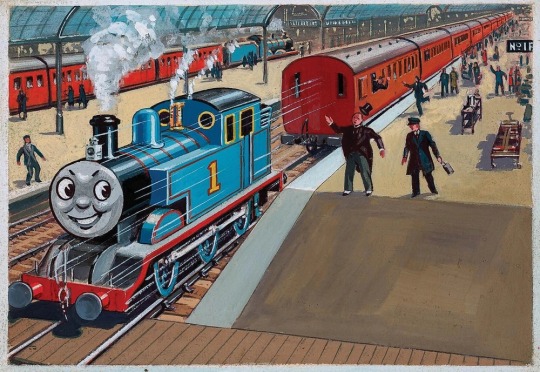

The Railway Series, however, would pick up a lot of the slack from this loss, as many of its earliest stories were in that same moral vein as traditional 'engine culture' stories, focusing on listening to elders, not stopping in tunnels, being patient, gentle with coaches, careful with trucks - it's all there. And I can see that being due to Edward teaching the Reverend many of these stories, in a bid to keep them from vanishing. And he would continue on, joined by other older engines like Skarloey, Rheneas and Toby, as the book series went on. Things like listening to advice and not acting recklessly pop up constantly - especially with Duncan, who Skarloey had to deal with.
It all gets worse when British Railways forms though. And this is where the 'railway rulebook', the attitudes of diesels and the doctrine of BR all come in to play. As the doctrine and official rulebook of British Railways portrays steam engines as inferior, weaker engines, the diesels are indoctrinated into believing it - and thus, they refuse to listen. Take Diesel for example, who believes that diesels can just arrive at a yard and 'improve it'. He is immediately foiled by some jammed breaks - something he may have learnt about from a story or a tale from a steam engine. But he never stopped to listen. And it's the same across the country, across the world in fact. As the successful diesel classes prove themselves to their managers, they are rolled out and steam engines are withdrawn - and with that, so is the culture they were the keepers of.

But this isn't quite the end of this 'engine culture' yet, because one group willing to listen to the steam engines are the 'failures'. Engines like BoCo and Derek would be very willing to listen to the engines that have tales that may just help them. Stories like how to best use sand in a storm, or how to conserve energy over the Settle-Carlisle route. And so even as steam dies, these 'failures' hold their culture, and try their best to preserve it, alongside the preserved engines. The Railway Series does too, such as in 'Stepney the Bluebell Engine', where sanding is explicitly mentioned. Another group that take in this engine culture is the GWR diesel-hydraulics, who grew up with GWR ideology, and thus would have been more willing to listen to their steam ancestors.

But these 'non-standard' engines were also quickly wiped out. And this leaves only a few pockets of engines who remember the old stories: the preserved engines, and the few Gen-1 diesels who did listen. By the end of the working lives of the Class 40s, the Deltics and the 'Peaks', they are the last engines who remember the old stories from the steam era working on British Railways, and when they are scrapped, the next generation grows up relearning everything.
Because the fact is that these stories held a major purpose, and the destruction of that culture means that every mistake every warned against is suddenly being made again, and again, and again. We notice this in the Railway Series, where Diesel, and Class 40, and D199 and even Bear all make very elementary mistakes that would have been warned against in these cultural stories - like taking care around trucks or looking out for the wind. And it only gets worse as this first generation are scrapped. Engines scramble to a standstill on leaves again, engines get trapped in floods, or lost in storms, or run through signals - and it's because the games, the songs, the stories, everything that would have prevented these accidents is lost.
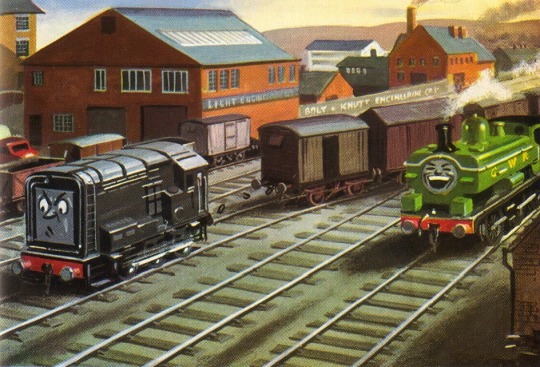
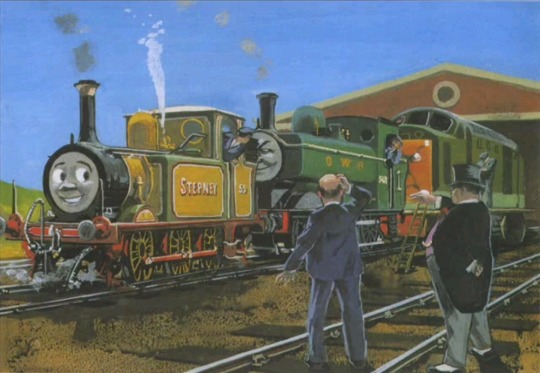
It's not until these diesels reach preservation that they hear the stories remembered by the steam engines, and that's when they realise that... hey, maybe the ancestors were right after all.
The saddest part is that it's not only a global thing, but that it's still very much a problem on modern railways. The loss of 'engine culture' between the 1950s and the 1980s would have a domino effect that would still impact modern railways, as the even newer electric engines and multiple units face the same issues but with no prior knowledge.
The pictures in this post are not mine.
#fanfiction writer#thomas the tank engine#weirdowithaquill#railways#railway series#the railway series#ao3 stuff#very long post#long reads#british rail#british railways#engine culture#ttte lady#ttte proteus#ttte diesel#ttte class 40#ttte stepney#ttte analysis
116 notes
·
View notes
Text
The inspiration for Gonagalls, found in Discworld.
With the Nac Mac Feegles, their musicians/poets are called Gonagalls. They are notoriously bad, and in fact are used to terrify the enemy. William McGonnagle, 1825-1902, according to Wikipedia: "gained notoriety as an extremely bad poet who exhibited no recognition of, or concern for, his peers' opinions of his work. " Additionally, "McGonagall has been lampooned as the worst poet in British history. The chief criticisms are that he was deaf to poetic metaphor and unable to scan correctly. His only apparent understanding of poetry was his belief that it needed to rhyme". And reading his poetry, I can now see that Pratchett modelled his poetry exactly on McGonagall's "metre". This is his poem about the Tay Bridge Disaster, a railroad bridge which had a terrible collapse, in the late 19th century:
Beautiful Railway Bridge of the Silv'ry Tay!
Alas! I am very sorry to say
That ninety lives have been taken away
On the last Sabbath day of 1879,
Which will be remember'd for a very long time.
10 notes
·
View notes
Note
hey! can you rec me some drarry falling in love fics? not super plotty, really sweet, fluffy fics please! don't care how long. preferrably 3rd person POV
Hi there! Absolutely, I highly recommend the ones below:
Secretly, between the shadow and the soul by @teacup-tai (2021, T, 3k)
The thing about surrender is that once you accept the unavoidable rhythm of change, the surprising uncontrollability of life, and the astonishing inevitability of feelings, it is easy.
Market Saturdays by @sorrybutblog (2021, M, 3.2k)
In which Harry is an accidental part-time cheesemonger, Draco is an organic farmer and they fall in love. Not an AU.
The Long Fall by @tackytigerfic (2021, M, 3.6k)
It's supposed to be a simple house renovation, and maybe it's just the paint fumes, but Harry is feeling dizzy around Draco Malfoy. And what's the real meaning of family, anyway?
He Whose Hand and Eye Are Gentle by khalulu (2017, G, 5k)
Draco reads poems and sometimes writes them. Harry receives poems and sometimes reads them. Rutherford delivers poems via the scenic route. Wombat snores. Eventually, all comes together, with help from the foxes in red bibs and the sumo referee.
Mise en Place by @corvuscrowned (2021, T, 5k)
Draco needs to learn how to cook, and luckily, Harry knows his way around a kitchen. The fact that Draco is using his newfound cooking skills to impress another man... Well, Harry just tries not to think about that too much.
Proof of the Pudding by daisymondays (2017, T, 10k)
When Greg's bakery opens on Diagon Alley, Draco doesn’t expect it to the place he ends up finding love, but then again Harry Potter has always defied Draco's expectations.
the way you make me glow by @softlystarstruck (2022, M, 11k)
In a cottage next to the sea, love blossoms. Or perhaps it’s been there all along.
Poppiholla by @moonflower-rose (2021, M, 12k)
Harry had accepted that he would pine silently for Malfoy forever, but one, humid summer might change that.
Bridges by @cavendishbutterfly (2021, E, 16k)
Harry and Draco are on a trip to Budapest to help with Kingsley's re-election, but that's the boring bit. More interesting: Harry Potter is changing his Tinder preferences to include men.
An Improbable Bout of Summer Madness by @ghaniblue (2021, E, 16k)
Draco had planned a quiet, peaceful summer holiday with his son. The last thing he expected was to find Potter here, in Draco's little Cornish retreat. Making fudge in a shop? The idea was too ludicrous for words.
It's Friday (I'm in Love) by @punk-rock-yuppie (2018, E, 16k)
At first, Draco only hangs out with them on Fridays after work; then he starts shagging Potter after pub nights. Then all the rest of the gang tries to befriend Draco and even worse, Potter tries to date him. It’s an absolute disaster, if you ask Draco.
Take These Lies by @pennygalleon (2021, E, 19k)
There’s a portrait of his godfather in Draco Malfoy’s potions shop and Harry needs to know why. But that’s not why he keeps coming back.
amid this warm and steady sweetness by warmfoothills (2019, E, 21k)
Harry is not living in a period drama, no matter what his friends or his new house or Malfoy’s sudden affinity for horse-riding might suggest, and if one more person uses the word courting, he’s going to start hexing people.
Nice Things by aideomai (2020, M, 22k)
The first thing that happened was Theodore Nott came back from France.
With Great Yawns and Stretchings by sugar_screw (2016, T, 22k)
The coffee is very good. Really. And the cats are so cute. That's why Harry goes so often.
Safe As Houses by @xanthippe74 (2021, T, 24k)
After five years abroad, Harry’s thrilled to be home and working at the most prestigious ward-building firm in Britain. But everything gets turned upside down when he's assigned to work for Draco Malfoy—who somehow grew up to be just the sort of sexy bastard Harry goes for.
Seeker, Chaser, Keeper by VivacissimoVoce (2013, M, 59k)
Rumor has it that a wealthy investor is starting up a brand new professional Quidditch team and he’s looking for players. Harry and Draco both want to make the team, but there can be only one Seeker.
Tea and No Sympathy by who_la_hoop (2014, E, 70k)
It's Potter's fault, of course, that Draco finds himself trapped in the same twenty-four-hour period, repeating itself over and over again.
Little Deaths and How to Avoid Them (or Draco Malfoy's Guide to Stop Dying and Start Living Instead) by nerakrose and dustmouth (2018, M, 96k)
Malfoy is way too interested in coroner reports for somebody who's definitely not looking for ways to die, Harry wants to be friends with him, and Ginny wants to break up with Harry.
The Liars Department by @dorthyanndrarry (2020, T, 103k)
This is a story about Harry meeting up with Draco Malfoy four years after the war. And a story about Harry, well, not hating his job per say, but it's not like he has much to compare it to and it seemed fine. His whole life seemed fine.
198 notes
·
View notes
Text
The Scottish bridge haunted by a 'ghost train' after a tragic 1800s disaster

If you live near or have visited Dundee or Fife, it is likely you have crossed the Tay Bridge at some point.
The railway bridge carries trains across the Tay—the longest river in Scotland—between the two regions, and has stood for over 100 years. What you may not know, however, is that the bridge you see today is not the original, and is in fact the second bridge to occupy the site—following a tragic disaster.
According to legend, the train can be observed passing over the river where the track once would have been. Chilling sounds of screams can supposedly then be heard as the train disappears, as the poor souls on that fateful night plunged to their death in the freezing waters of the River Tay...
Daily Record
29 notes
·
View notes
Text
Listening to a podcast about the Tay Bridge collapse and its reminded me of my favourite completely bonkers idea I choose to believe which is that William Topaz McGonagall is essentially an incarnation of Cassandra. He keeps writing poems about disasters because he's having prophetic visions unfortunately his poems are simply so terrible everyone ignores the warnings and laughs at him for delivering them in lines such as:
I must now conclude my lay
By telling the world fearlessly without the least dismay,
That your central girders would not have given way,
At least many sensible men do say,
Had they been supported on each side with buttresses
21 notes
·
View notes
Text
🚂 Delve into more railway history with Mairi Shiels as she unravels the mysteries of the Tay Rail Bridge Disaster! 🌨️
Brace yourself for a chilling tale from history! Mairi Shiels is set to take you on a journey back to the Tay Rail Bridge Disaster. 🌉
Join us on 23rd January 2024, 2:30 PM, at St Andrews Bowling Club for an insightful talk. Learn about the wonders of the Victorian world and the shocking collapse that sent shockwaves through society.
🔍 Secure your ticket: https://tinyurl.com/wintertalk1
📅 Date: 23rd January 2024
🕰️ Time: 2:30 PM
📍 Venue: St Andrews Bowling Club

#geology#scotland#university#st andrews#fife#historicscotland#history#museum#railway#railroad#united kingdom#universityofstandrews#tourism#event
0 notes
Text


On January 21st 1890 two 1,000ft long test trains, each comprising a locomotive and 50 wagons, and l weighing 900 tons each, rolled onto the newly-built Forth Bridge side by side from the south.
Before the bridge we see today was built, the foundations of a completely different bridge were laid in 1878. Sir Thomas Bouch had designed a suspension bridge for the crossing, but in 1879 another bridge that Bouch had designed collapsed during the tragic Tay Bridge Disaster. During a storm, the Tay Bridge had collapsed under the weight of a train carrying 75 passengers, killing everyone on board. Following the disaster, Bouch’s design for the Forth Bridge was quickly abandoned. Today you can still see the foundations for his bridge on Inchgarvie, an uninhabited military island in the Forth.
Work had been completed on the crossing in December 1889.
The first weight testing of the new Forth Bridge began on the 21st of January 1890, and was naturally a very cautious process, this is a report from The Edinburgh Evening News, from Tuesday, January 21, 1890:
"It had been decided, for the purpose of the experiment, to take a double train of waggons over the bridge, for this purpose the vehicles, with three engines, were brought to the north end of the structure. The whole weight 2000 tones, the engines themselves weighing 75 tonnes each. The trains were allowed to stand side by side on the southern approach viaducts, a short distance from the first granite archway. At a later hour the trains moved very slowly until the leading engine was half way out over the arch. Another wait took place, and then the trains again went forward and passed through the ironwork of the first cantilever. During the proceedings, none but the engineers were allowed on the bridge, and observations as to the effect of the weight on the structure were taken at various points. About one o’clock the trains passed onto the Inchgarvie cantilever."
The bridge finally opened on the 4th March 1890, becoming the world’s longest cantilever bridge.
Although nowadays most people call the bridge, The Forth Rail Bridge, it's official name, as it was when it was built, and the only crossing this far east. is The Forth Bridge.
21 notes
·
View notes
Text
Events 12.28 (before 1920)
418 – A papal election begins, resulting in the election of Pope Boniface I.
457 – Majorian is acclaimed as Western Roman emperor.
484 – Alaric II succeeds his father Euric and becomes king of the Visigoths. He establishes his capital at Aire-sur-l'Adour (Southern Gaul).
893 – An earthquake destroys the city of Dvin, Armenia.
1065 – Edward the Confessor's Romanesque monastic church at Westminster Abbey is consecrated.
1308 – The reign of Emperor Hanazono of Japan begins.
1659 – The Marathas defeat the Adilshahi forces in the Battle of Kolhapur.
1768 – King Taksin's coronation achieved through conquest as a king of Thailand and established Thonburi as a capital.
1795 – Construction of Yonge Street, formerly recognized as the longest street in the world, begins in York, Upper Canada (present-day Toronto).
1832 – John C. Calhoun becomes the first Vice President of the United States to resign. He resigned after being elected Senator from South Carolina.
1835 – Osceola leads his Seminole warriors in Florida into the Second Seminole War against the United States Army.
1836 – South Australia and Adelaide are founded.
1836 – Spain recognizes the independence of Mexico with the signing of the Santa María–Calatrava Treaty.
1846 – Iowa is admitted as the 29th U.S. state.
1879 – Tay Bridge disaster: The central part of the Tay Rail Bridge in Dundee, Scotland, United Kingdom collapses as a train passes over it, killing 75.
1885 – Indian National Congress, a political party of India, is founded in Bombay Presidency, British India.
1895 – The Lumière brothers perform for their first paying audience at the Grand Cafe in Boulevard des Capucines.
1895 – Wilhelm Röntgen publishes a paper detailing his discovery of a new type of radiation, which later will be known as x-rays.
1902 – The Syracuse Athletic Club defeat the New York Philadelphians, 5–0, in the first indoor professional football game, which was held at Madison Square Garden.
1908 – The 7.1 Mw Messina earthquake shakes Southern Italy with a maximum Mercalli intensity of XI (Extreme), killing between 75,000 and 200,000.
1912 – The first municipally owned streetcars take to the streets in San Francisco.
1918 – Constance Markievicz, while detained in Holloway prison, becomes the first woman to be elected Member of Parliament (MP) to the British House of Commons.
0 notes
Text
The Scottish bridge haunted by a ‘ghost train’ after a tragic 1800s disaster
If you live near or have visited Dundee or Fife, it is likely you have crossed the Tay Bridge at some point. The railway bridge carries trains across the Tay—the longest river in Scotland—between the two regions, and has stood for over 100 years. What you may not know, however, is that the bridge you […]
The Scottish bridge haunted by a ‘ghost train’ after a tragic 1800s disaster
🌉 BHC
Happy…

View On WordPress
0 notes
Text
The Best Bad Poetry
New blog post: The Best Bad Poetry.
A few days ago, I received an email from a blog I didn’t know I was following.
The author had just updated with a poem about the Ship Canal Bridge in Seattle that was heavily influenced by the William McGonagall verse The Tay Bridge Disaster. For the avoidance of doubt, only the style is lampooned; the Seattle bridge is in no danger of collapse.
I’m from Dundee, right next to the Tay, and…

View On WordPress
#blogging#Dundee#dundee rep theatre#editing#performance#poetry#tommy wiseau#William McGonagall#writing
1 note
·
View note